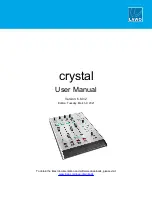
HK 31
22
ANBAU AN DEN SCHLEPPER
Der Kreisel-Rotavator ist für Schlepper mit genormtem
Dreipunktgestänge der Kat. 2 bzw Kat 3 konstruiert. Der Anbau
erfolgt zentral.
ATTACHING THE HARROVATOR TO THE
TRACTOR
The Harrovator is suitable for attachment to tractors equipped
with especially Cat. 2 respectively Cat 3 three point linkage
.
Es ist unbedingt darauf zu achten, daß
die Profilrohre der Gelenkwellen in
kürzester Stellung nicht stauchen und
in der längsten Stellung nicht
auseinanderfallen.
NOTE it is essential that the PTO Drive
Shaft is set to a SAFE WORKING
LENGTH to ensure that the male shaft
does not >bottom< in or separate from
the female tube under all conditions of
use and transport.
Um die richtige Anbauposition zu ermitteln, wird der Kreisel-
Rotavator auf festem, ebenem Boden abgestellt und über die
Tiefenkontrollausrüstung die Getriebeantriebswelle horizontal
ausgerichtet.
Fahren Sie den Schlepper auf eine Distanz vor den Kreisel-
Rotavator, die eine Mindestüberlappung der Gelenkwellenprofilrohre
von 200 mm gewährleistet, wenn die Gelenkwelle angeschlossen ist.
Die Schlepperunterlenker auf die Kuppelstange stecken und mit
Klappsplint sichern. Schlepperunterlenker gegen seitliches Spiel
verriegeln.
Die Gelenkwelle auf die Schlepperzapfwelle aufschieben und den
Gelenkwellenschutz durch Einhängen der Kette am Kreisel-
Rotavator gegen Mitlaufen sichern.
Den Oberlenker mittels Anbaubolzen am Oberlenker-Anbaubock
befestigen und mit Klappsplint sichern. Durch Verlängern oder
Kürzen des Oberlenkers wird die Maschine waagerecht ausgerichtet
(siehe Fig. 22/1.).
Nach dem Anbau ist der Maschine über die Hubspindel der
Schlepperhydraulik in ihrer Arbeitsbreite waagerecht zur
Schlepperachse auszurichten (siehe Fig. 23/1).
Bevor die Schlepperzapfwelle eingeschaltet wird, den Kreisel-
Rotavator mit der Hydraulik ausheben, bis die Gelenkwelle einen
Winkel von 40° erreicht hat. Jetzt die Hubbegrenzung auf diese
Stellung einstellen (siehe Fig. 23/2).
Die Gelenkwelle darf in Arbeitsstellung nur bis 15°abgewinkelt
werden. Beim Ausheben bis zu 40° muß die Schlepperzapfwelle
ausgeschaltet werden.
With the Harrovator on a firm level surface adjust the Depth
Control equipment until the Gearbox input shaft is horizontal
(Fig. 22/1).
Position the tractor at a distance from the Harrovator to give
200 mm minimum engagement of the male half of the PTO
Drive Shaft in the female tube when connected to the tractor.
This establishes the safe working length of the PTO Drive
Shaft for connection to the tractor.
Position the tractor lower link ball joints in line with the lower
coupling bar. Connect the tractor lower links. Fit the tractor
upper link and secure.
Attach the PTO Drive Shaft to the tractor ensuring the quick
release pin engages the tractor and Harrovator.
Attach stabiliser bar or check chains to limit sway to 50 mm
(2“). Adjust tractor linkage to level the Harrovator laterally and
longitudinally (Figs. 22/1 and 23/1).
For driving stability and safety ensure sufficient front wheel
weights are fitted to the tractor to compensate for the mounted
Harrovator.
Before engaging the tractor PTO lift the Harrovator on the
hydraulic linkage until the blades are 10-20 cm above ground
level and set the limit stop on the hydraulic lift control quadrant
accordingly.
THE PTO DRIVE SHAFT ANGLE MUST NEVER EXCEED
40°
(Fig. 23/2)
To disconnect the Harrovator from the tractor adopt the same
procedures ensuring that the Harrovator is stable and, or fully
supported prior to disconnection.
Beim abgestellten Kreisel-Rotavator ist
die Gelenkwelle in den Haken am
Oberlenker einzuhängen.
When disconnecting the Harrovator off
the tractor, put the PTO shaft into the
PTO shaft support.
Fig.22/1












































